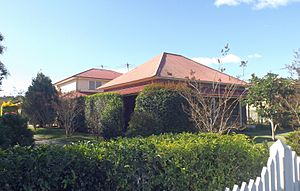Killarney, Enoggera facts for kids
Quick facts for kids Killarney, Enoggera |
|
|---|---|

Residence in 2015
|
|
| Location | 9 Laurel Street, Enoggera, City of Brisbane, Queensland, Australia |
| Design period | 1840s–1860s (mid-19th century) |
| Built | c. 1860 |
| Official name: Killarney | |
| Type | state heritage (built) |
| Designated | 21 October 1992 |
| Reference no. | 600194 |
| Significant period | 1860s (fabric) 1860s-1890s (historical) |
| Significant components | tank – water (underground), residential accommodation – main house, garden/grounds |
| Lua error in Module:Location_map at line 420: attempt to index field 'wikibase' (a nil value). | |
Killarney is a historic house located at 9 Laurel Street in Enoggera, Brisbane, Australia. It was built around the 1860s and is one of the oldest homes in the area. This house is special because it shows us what early homes in Queensland were like. It is listed on the Queensland Heritage Register, which means it's an important part of Queensland's history and should be protected.
Contents
A Glimpse into Killarney's Past
Killarney was likely built in the 1860s for Timothy Corbett. He was an Irish immigrant who came to Moreton Bay (now Brisbane) very early, possibly before 1842. Timothy was a farmer and a property owner in Brisbane. He was also a well-known person in the community.
Timothy Corbett and Early Settlement
Timothy Corbett bought land along Kedron Brook in the 1850s. This area was known for farming, with vineyards and orchards. It was also a gateway to other farming towns. It's believed that Timothy and his wife, Alice Finn, moved to Killarney in the 1860s. They were among the first families to settle along Kedron Brook.
The Corbetts were very involved in their community. Timothy and his neighbor, James Mooney, even gave some of their land to help start the Enoggera Primary School. This school opened in 1871. The Corbett family's property was a popular spot for community gatherings.
How the Area Changed Over Time
For a long time, the Kedron Brook area was mostly a quiet farming community. But things started to change when the railway line was extended to Enoggera railway station in 1889. After the railway arrived, the area slowly became more like a suburb. By the 1920s, it had divided into several smaller suburbs like Alderley and Enoggera. The area also started to have more industries, like sawmills and brickworks.
Killarney's Owners Through the Years
After Timothy Corbett passed away in 1887, Killarney went to his eldest son, Edward Joseph Corbett. Edward was a lawyer and a leader in the local government. He lived at Killarney with his wife, Cecelia, and his mother, Alice. After Edward's early death in 1893, the house was managed by his wife and brother.
The Corbett family owned Killarney until the 1910s. After that, it became a rental property for a while. In 1912, David Rhoades bought the Corbett farm and divided the land into smaller blocks for homes. Killarney and its remaining land were then sold to the Tate family in 1925. Later, it was owned by Emily Firrell in 1934, and then by her daughter, Beryl Agnes Farry, in 1948.
What Killarney Looks Like
Killarney was originally a single-story house with four rooms. It had a verandah all around it. The house was built using handmade bricks. It had a simple roof made of corrugated iron. The front windows were old-style double-hung windows. French doors opened onto the side verandahs, which had wide timber posts. Inside, the brick walls were covered with plaster, and the ceilings were made of cedar wood.
Over the years, the inside of the house has been updated. A modern kitchen was added, and a bathroom was built on the back verandah. The original kitchen, which was separate from the main house, was taken down in 1975. Its bricks were reused to build a new four-room section that connects to the main house. There is also an old underground water tank in the backyard.
Why Killarney is Important
Killarney is listed on the Queensland Heritage Register for several reasons:
- It shows how Queensland's history developed, especially the early farming days in the Kedron Brook/Enoggera area.
- It's one of the few surviving houses from the mid-1800s in Brisbane. It's also a rare example of a brick house from that time in Queensland. Studying it can help us learn about early brickmaking.
- The house has a simple, rustic beauty.
- It has a strong connection to Timothy Corbett and his family, who were important early settlers in Queensland.

